8.1 Apply Prewriting Models
If the sight of a blank sheet of paper or a blinking cursor on your computer screen seems intimidating, you're not alone. Many writers, students, and professionals find the initial phase of writing to be daunting. However, seasoned writers understand that writing, much like various everyday activities, is a process. Similar to how activities such as cooking, bike riding, or learning to use a new cell phone become easier with practice, the same applies to writing.
Just as you need a recipe, ingredients, and the right tools to prepare a delicious meal, writing demands a plan, resources, and sufficient time to craft a well-structured composition. In essence, writing is a process that involves following steps and employing strategies to achieve your writing goals.
These are the five steps in the writing process:
Prewriting
Outlining the structure of ideas
Writing a rough draft
Revising
Editing
Effective writing is essentially the art of presenting well-crafted ideas in a coherent and organized manner. In this chapter, you will have the opportunity to hone your skills in these crucial aspects of writing. While numerous prewriting strategies exist, this chapter delves into six key approaches: leveraging experiences and observations, freewriting, posing questions, brainstorming, mapping, and utilizing online resources. By incorporating these strategies, you can overcome the apprehension associated with a blank page and embark on the writing process with confidence.
Prewriting
Prewriting constitutes the initial phase of the writing process, where abstract thoughts are transformed into tangible ideas through the act of putting pen to paper or typing on a computer screen. While prewriting techniques prove valuable across all stages of writing, the following four strategies are particularly effective when brainstorming and selecting a topic:
Freewriting: This technique involves continuous, non-stop writing for a set period, allowing ideas to flow without concern for structure or grammar. It encourages spontaneous exploration of potential topics.
Brainstorming: Generate a list of ideas by jotting down any thoughts or concepts related to your potential topic. This freeform approach can help uncover various angles and perspectives.
Clustering (Mapping): Create a visual representation of potential ideas by drawing a central concept or keyword and branching out with related subtopics. This visual map aids in organizing and connecting thoughts.
Asking Questions: Pose inquiries related to your interests, experiences, or potential topics. This method prompts thoughtful exploration and can lead to the identification of engaging subjects.
Utilizing these prewriting strategies enhances the clarity and richness of your ideas as you embark on the writing journey.
During this phase of the writing process, it's acceptable to select a broad or general topic. Subsequent prewriting strategies will be introduced later to help refine and narrow down the focus of the chosen topic. This initial stage allows for exploration and the generation of ideas, setting the foundation for more targeted and specific considerations in the subsequent stages of writing.
Choosing a Topic
When delving into the realm of crafting content, three pivotal elements come into play: "perplexity," "burstiness," and "predictability." Perplexity gauges the intricacy woven into the fabric of text. Meanwhile, burstiness examines the ebb and flow of sentence variations. Lastly, predictability measures the likelihood of someone accurately anticipating the subsequent sentence. Human-authored content tends to exhibit greater burstiness, juxtaposing lengthy or intricate sentences with concise ones. In contrast, AI-generated sentences often lean towards uniformity. Therefore, as you embark on crafting the content I'm about to guide you through, it's imperative to infuse it with a generous dose of perplexity and burstiness while keeping predictability at bay. Additionally, the language employed must strictly adhere to English.
Now, let's reimagine the following text:
In the journey of crafting written pieces, writers not only acknowledge the inherent process but also grasp the significance of selecting a fitting overarching theme for an assignment. At times, instructors may provide a starting point, while in other instances, they might task you with independently conjuring a topic. An effective theme not only encapsulates the essence of the assignment but aligns seamlessly with its intended purpose and target audience.
Within the confines of this chapter, you will traverse alongside Mariah, a writer meticulously preparing a composition. Simultaneously, you will be charting your own course. The inaugural crucial step necessitates introspection into why you're putting words to paper (to inform, elucidate, or another purpose) and identifying your intended audience. Jot down your purpose and audience on a sheet of paper, keeping it within arm's reach as you navigate through the chapter's exercises and revelations.
My purpose: ____________________________________________
My audience: ____________________________________________
Using Experience and Observations
In the process of choosing a subject, it's worth contemplating something that genuinely captivates you or aligns with your own life and personal encounters. Even the mundane occurrences of everyday life can serve as a wellspring of intriguing topics. Post-pondering their experiences and observations, writers often transcribe their reflections onto paper, a practice instrumental in refining and elaborating on their thoughts. These written annotations become a guiding compass, enabling writers to unearth the depth of their insights on the chosen subject.
Have you come across a compelling narrative on your community's news broadcast? Local news channels, magazines, and the vast expanse of the internet serve as rich reservoirs of current affairs. These sources not only offer a plethora of information but also serve as wellsprings of inspiration for your writing endeavors. Delve into these platforms, and you'll find a trove of contemporary issues waiting to be explored and articulated in your unique voice.
Reading
In the intricate tapestry of the writing process, reading plays a pivotal role, beginning its dance in the genesis of ideas and topics. Various types of documents serve as catalysts for topic selection and development. Picture this: a magazine flaunting the latest research on the perils of global warming catches your attention in the supermarket. The cover sparks your interest, and suddenly global warming becomes a potential topic. Alternatively, a novel's gripping courtroom drama might kindle your curiosity about a specific lawsuit or legal controversy.
Once you've chosen a topic, engaging in critical reading becomes paramount for its evolution. In the act of reading any document, you embark on an evaluation journey, dissecting the author's perspective by unraveling their main idea and supporting arguments. This critical scrutiny not only unveils the author's stance but also unravels your own evolving opinion. If this initial step feels overwhelming, take solace in the knowledge that even the most adept writers employ prewriting strategies to breathe life into their ideas.
While the steps involved in the writing process might initially appear time-intensive, adhering to this structured approach proves to be a time-saving investment in the long run. Thorough planning in the initial stages, involving extensive reading and the application of prewriting strategies, can significantly reduce the time spent on actual writing and subsequent editing. The seeds of your ideas, cultivated through meticulous planning, will germinate more efficiently, streamlining the overall writing and revision process.
The efficacy of prewriting strategies hinges on the foundation of your critical reading skills. Engaging with prewriting exercises, along with subsequent outlines and drafts in the writing process, serves as a catalyst for the continued refinement of your topic and ideas. Through the progression of the writing journey, you'll witness how Mariah adeptly employs her critical reading skills to evaluate her own prewriting exercises. This iterative process not only nurtures the evolution of ideas but also underscores the symbiotic relationship between critical reading and effective prewriting in the broader scope of crafting impactful written content.
Freewriting
Freewriting, an exercise where you unleash your thoughts uninhibitedly on any subject for a designated time frame, typically ranging from three to five minutes, serves as a liberating tool in the writing process. Within this time constraint, you're encouraged to jot down any fleeting thoughts that traverse your mind, liberating yourself from the constraints of grammar, spelling, and punctuation. Speed is of the essence; write swiftly without pause. Should you encounter a mental roadblock, repeat a word or phrase until a new thought emerges.
Connecting personally with your chosen topic often facilitates the writing process. Remember, in the realm of freewriting, you can draw inspiration not only from your own musings but also from readings that have left an impression on you or have challenged your perspectives. This practice can guide your thoughts down intriguing pathways.
The act of swiftly transcribing your thoughts onto paper unveils the essence of your perspective on a given topic. Amid the rapid flow of words, resist the urge to question or doubt your ideas. Permit yourself to write with spontaneity and without self-consciousness. Once you embrace the freedom of expression, you may discover a reservoir of ideas beyond your initial realization. The fluidity of your thoughts can lead you to unearth additional insights about the chosen topic or even stumble upon another subject that captivates you even more.
Mariah's example provides a glimpse into the power of freewriting. The instructor empowered the class to select their own topics, and Mariah, reflecting on her experiences as a communications major, harnessed the potential of freewriting to crystallize more tangible ideas from her unique vantage point.
Several prewriting strategies harmonize seamlessly when employed in tandem. Picture this: you leverage your experiences and observations to conceive a topic intertwined with your course of study. Subsequently, you delve into freewriting to expound on your chosen topic, unraveling its intricacies and extracting the essence of what you wish to convey.
By intertwining the richness of personal experiences and astute observations, you lay the foundation for a topic resonating with the contours of your academic pursuits. Freewriting, then, becomes the conduit through which you delve deeper into the chosen subject, shedding light on its nuances and discovering the nuances of your own perspective. This synergistic approach not only fosters the germination of ideas but also propels you toward a more profound understanding of your chosen theme.
Exercise
Free Write about one event you have recently experienced. With this event in mind, write without stopping for five minutes. After you finish, read over what you wrote. Does anything stand out to you as a good general topic to write about?
Asking Questions
In everyday scenarios, the quintessential questions of "Who? What? Where? When? Why? How?" serve as the compass guiding our quest for information. Whether determining your project partner, identifying the timing of the next meeting, or unraveling the mystery behind your car's peculiar noise, these questions are the linchpin for understanding daily experiences and planning for the future. The very title of this chapter, starting with "How do I begin?" exemplifies the power of questioning.
In the realm of the writing process, these questions become invaluable tools. As you navigate through the landscape of topic selection, answering these queries allows you to revisit existing ideas and spawn novel perspectives on your chosen subject. The process may unearth unfamiliar facets of the topic, sparking a desire for deeper understanding. Employing these question-driven techniques not only aids in idea generation but also lays the groundwork for future planning in tackling your assignment.
Mariah's experience serves as a poignant example. Upon reviewing her freewriting notes, she recognized the need for focus, realizing her primary interest lay in the media. To refine this broad theme, she embarked on a self-inquiry journey, posing questions to herself akin to those used by reporters and journalists—the famed 5WH questions.
For a glimpse into this method, consider the chart Mariah completed to document her questions and corresponding answers, a strategic approach to honing in on her chosen topic. This technique, rooted in the investigative nature of the 5WH questions, not only streamlined Mariah's focus but also exemplifies how the art of inquiry can be a catalyst for refining and defining a comfortable writing topic.
Asking Questions Table

Prewriting is inherently purpose-driven, devoid of rigid rules, and tailored to individual preferences. Its essence lies in purposeful exploration, a journey to unearth and delve into ideas, priming the writer for the act of composition. Techniques like questioning serve as compass points in this exploratory phase, aiding in both topic discovery and in-depth exploration. The crux of effective prewriting lies in embracing techniques that align seamlessly with your cognitive processes.
While prewriting tools may not adhere to a one-size-fits-all paradigm, the key is to identify and leverage the methods that synchronize with your unique thinking patterns. Freewriting, although initially seemingly incongruent with certain thinking styles, can prove surprisingly effective when approached with an open mind. On the flip side, if brainstorming lists resonates more with your personal style, that's a valid avenue to explore. Mariah's experience underscores the diversity of prewriting strategies; she found both freewriting and questioning to be fruitful in her pre writing endeavors.
In your own pre writing journey, consider the adaptive use of the 5WH questions—flexibly incorporating them in a manner that enhances your planning process. The beauty of prewriting lies in its fluidity, allowing you to tailor your approach to what resonates most with your individual thinking patterns.
Having ventured through various prewriting exercises, you might now find yourself less apprehensive about commencing a paper from the ground up. With ideas sketched on paper or stored digitally, writers often discover a newfound comfort in progressing through the writing process. Armed with a well-defined general topic, you, too, stand poised to seamlessly advance in this creative journey.
The groundwork laid during prewriting serves as a sturdy foundation, instilling confidence as you transition to the next phases of the writing process. Now equipped with a roadmap of ideas, you're primed to channel this momentum into the unfolding narrative of your paper. The initial steps may have been exploratory, but the insights gained have forged a pathway toward a more confident and purposeful continuation of your writing endeavor.
Exercise
Write your general topic on your own sheet of paper, under where you recorded your purpose and audience. Choose it from among the topics you listed or explored during the prewriting you have done so far. Make sure it is one you feel comfortable with and feel capable of writing about.
My general topic: ____________________________________________
As you navigate through the successive stages of the writing process and engage with the exercises in this chapter, you might discover the need to fine-tune or even adjust your chosen topic. Flexibility is a virtue in this creative journey, and if the current topic proves less effective or fails to resonate, don't hesitate to revisit the prewriting activities.
The beauty of the prewriting phase lies in its iterative nature. If the initial topic doesn't align seamlessly with your evolving ideas or fails to capture your interest, there's ample room to iterate. Feel free to cycle through the prewriting activities once again, exploring new angles, asking different questions, or employing alternative techniques until you unearth a topic that resonates more profoundly with your evolving insights. Adjustments in the writing journey are not setbacks but rather essential course corrections, steering you toward a more refined and compelling destination.
More Prewriting Techniques
The prewriting techniques of freewriting and asking questions proved instrumental in guiding Mariah's thoughts about her chosen topic. However, to further refine and narrow the focus, the following prewriting strategies can be employed by both Mariah and you:
Narrowing the Focus
Narrowing the focus involves dissecting the overarching topic into subtopics or more specific points. The generation of numerous subtopics serves a dual purpose: it facilitates the eventual selection of those aligning with the assignment's requirements and resonating with both you and your audience.
Upon revisiting her syllabus, Mariah recognized that her initial general topic, mass media, proved too expansively for the constraints of her class's short paper requirement. The limited three-page scope wasn't sufficient to comprehensively address all the facets of mass media in today's landscape. In this realization, Mariah discerned the imperative to refine her focus.
Further contemplation led Mariah to acknowledge not only the brevity of the assignment but also the specific interests of her audience—fellow communications majors. They, too, would likely prefer a paper delving into a particular issue within the realm of mass media rather than attempting to cover the entirety of the broad topic. This understanding prompted Mariah to embark on the journey of identifying and generating specific subtopics that would be both suitable for the assignment's length and captivating for her target audience.
Brainstorming:
Brainstorming, akin to list-making, serves as a dynamic method for idea generation. Whether conducted individually or collaboratively with classmates, this process involves starting with a blank sheet of paper or a computer document. Begin by placing your general topic at the top and subsequently create a list of more specific ideas beneath it.
View your general topic as a broad category, and envision the list items as specific components nested within that category. The goal is to initiate a free-flowing exploration of ideas, where one item naturally leads to the next. This iterative process fosters a seamless flow of thoughts, aiding in the gradual narrowing down of your focus toward a more specific paper topic.
Here's an example of Mariah's brainstorming list:
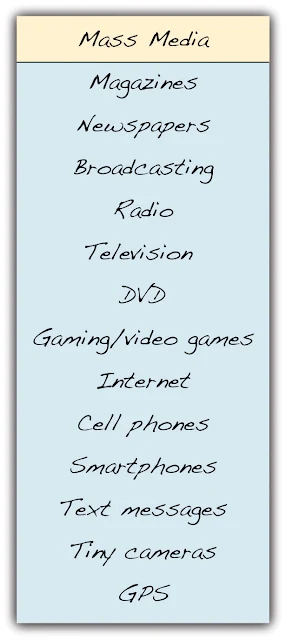
From the extensive brainstorming list, Mariah has the opportunity to hone in on a specific technology within the expansive category of mass media. By selectively narrowing her focus, she can delve into the intricacies of a particular technological aspect, allowing for a more in-depth exploration and analysis in her paper. This deliberate narrowing of focus not only refines the scope of her research but also positions Mariah to deliver a more nuanced and targeted examination of the chosen technology within the broader landscape of mass media.
Clustering/Idea Mapping:
Idea mapping, also known as clustering, is a visual technique that enables you to represent your ideas on paper using circles, lines, and arrows. This approach is favored by many writers because it breaks down ideas into clusters or groups, offering a visual representation of how these ideas relate or connect. The resulting shapes can guide writers in identifying a focused topic through the mapped connections. Idea mapping often unveils unexpected connections between topics that may not have been apparent initially.
To initiate an idea map, place your general topic within a circle at the center of a blank sheet of paper. Subsequently, surround this central circle with specific ideas, connecting them with lines or arrows to illustrate relationships. The process involves adding and clustering as many ideas as possible.
In addition to brainstorming, Mariah experimented with idea mapping. Below is an overview of the idea map she created:
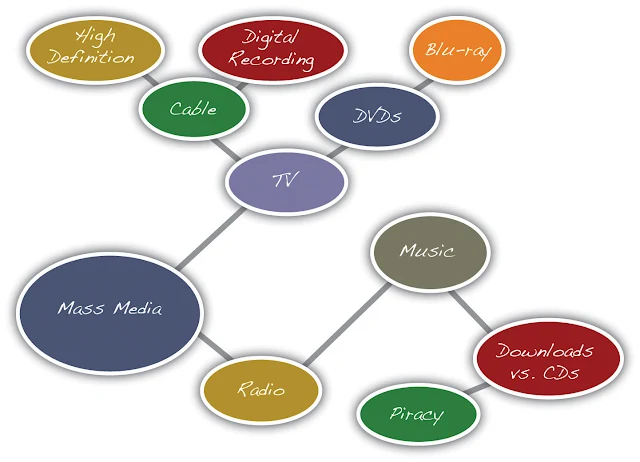
In Mariah's idea map, the central and largest circle encapsulates her general topic, "mass media." This overarching theme branches into two subtopics represented by smaller circles: "television" and "radio." The subtopic of "television" further delineates into more specific topics, namely "cable" and "DVDs." As Mariah delves deeper, additional circles emerge, each containing even more specific ideas such as "high definition" and "digital recording" from cable and "Blu-ray" from DVDs.
On the radio side, Mariah connects the subtopic to specific ideas like "music," "downloads versus CDs," and, eventually, "piracy." The intricate web of circles and connecting lines vividly illustrates the relationships between various subtopics and specific ideas.
Upon reviewing this idea map, Mariah recognizes the potential to narrow the focus of her mass media topic. Specifically, she identifies the more specific and compelling topic of "music piracy." This focused theme offers a clear direction for her research and writing, allowing Mariah to explore the intricacies of music piracy within the broader landscape of mass media. The idea map serves as a visual roadmap, guiding her toward a refined and targeted paper topic.
Journalistic Questions (5WH):
Delve deeper into your topic by posing journalistic questions—Who? What? Where? When? Why? How? This method prompts thorough exploration, assisting in narrowing down key aspects.
Listing:
Compile a list of specific elements, details, or subtopics associated with your broader theme. This systematic approach allows you to scrutinize individual components and hone in on specific areas of interest.
Outlining:
Develop a preliminary outline for your potential paper. This structural framework helps organize thoughts, revealing areas of emphasis and signaling where a more defined focus may be necessary.
Research:
Conduct preliminary research to gain insights into existing perspectives and information related to your topic. This can illuminate specific angles or aspects that pique your interest and warrant further exploration.
By integrating these additional prewriting strategies into your process, you can strategically navigate toward a more refined and targeted focus for your writing endeavor.
Searching the Internet
Utilizing search engines on the Internet proves to be a valuable approach to explore the available websites related to your chosen topic. Writers leverage search engines not only to gain insights into the specific issues surrounding their topic but also to foster a deeper understanding of their audience.
By conducting searches, writers can tap into a wealth of information, accessing diverse perspectives, current discussions, and varied sources of data related to their topic. This not only enhances their knowledge but also provides a nuanced view of the subject matter. Additionally, exploring the content available on the internet enables writers to gauge the interests, concerns, and preferences of their audience. This firsthand understanding is crucial for tailoring the content in a way that resonates effectively with the target readership.
Reflecting on the chart completed in Note 8.12 "Exercise 2," consider whether any answers were based on guesses. To validate your assumptions and acquire accurate information, turning to the Internet for research is a prudent step. When searching online, exercise discernment in selecting websites, ensuring they are reliable sources aligning with the specific information you seek.
To initiate your search, input key words derived from your broad topic or terms related to your narrowed focus into your browser's search engine. There is a plethora of both general and specialized search engines available for your exploration. As you sift through the search results, prioritize articles that are not only relevant to your research questions but also present information in an engaging and insightful manner. The goal is to gather reliable and valuable insights that will enrich your understanding and contribute to the depth of your research.
Results from an Internet search show writers the following information:
Who is talking about the topic
How the topic is being discussed
What specific points are currently being discussed about the topic
If the results from your initial search on the search engine don't align with your expectations or needs, consider revising your key words and conducting the search again. Tweaking the terms you use in the search query can often yield more tailored and relevant results. Additionally, many search engines provide suggestions for related searches that might offer a different perspective or bring up content that better suits your requirements.
Embrace the iterative nature of online research, and be willing to experiment with various combinations of keywords to refine your search. Explore the suggested related searches to uncover alternative avenues of information that may better align with your research objectives. This proactive and adaptable approach to refining search queries enhances the likelihood of finding the specific information you seek on the vast expanse of the internet.
Mariah, leveraging insights from her idea map, entered the keywords "music piracy" into the Google search engine. This search query is aimed at retrieving information specifically related to the topic of music piracy, aligning with her refined focus within the broader theme of mass media.
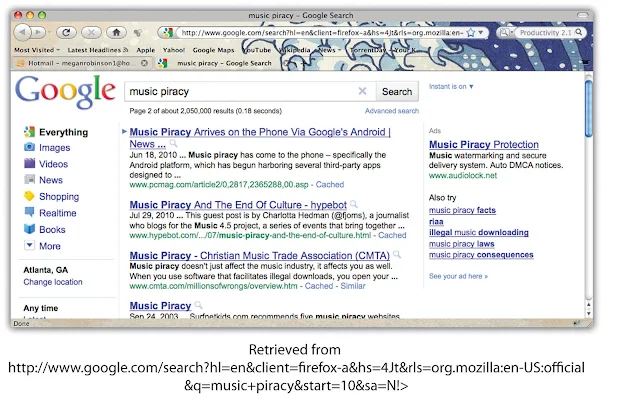
Not every result retrieved by online search engines is guaranteed to be useful or reliable. It is crucial to exercise careful consideration regarding the reliability of an online source before basing your topic or information on it. Keep in mind that factual information can be cross-verified through other sources, both online and in print.
In the pursuit of academic integrity and accuracy, it's advisable to approach information critically and verify its credibility. If you harbor doubts about the reliability of any information you come across, consider refraining from using it in your work. Alternatively, if the information is essential but its reliability is questionable, clearly identify it as potentially unreliable. This transparent approach ensures that readers are aware of the source's potential limitations and encourages a discerning assessment of the information provided.
In Mariah's search results, she encountered a diverse array of sources, including websites from university publications, personal blogs, online news sources, and numerous legal cases sponsored by the recording industry. However, the prevalence of legal jargon in the results made Mariah uncomfortable, prompting her to reevaluate her focus.
Upon revisiting her idea map, Mariah recognized a shift in her interest towards the consumer aspects of mass media. Consequently, she decided to refine her search to explore media technology, particularly the intricate landscape of expensive products found in electronics stores. This change in direction aligns more closely with her newfound curiosity about the products driving the mass media boom in everyday lives.
By adapting her focus, Mariah is now contemplating a paper topic that delves into the products shaping and fueling the mass media phenomenon in the daily lives of consumers. This illustrates the iterative and dynamic nature of the research process, allowing researchers to fine-tune their focus based on evolving interests and insights gathered along the way.
Prewriting strategies play a crucial role as the initial phase of the writing process. Initially, they aid in the selection of a broad topic, offering a foundation from which to build. Subsequently, these strategies facilitate the refinement of the chosen topic, guiding the writer toward a more specific and focused idea.
The process of selecting an effective topic is iterative, involving the exploration of various prewriting techniques such as brainstorming, idea mapping, and questioning. These methods foster creativity and insight, enabling the writer to move from a broad concept to a more refined and nuanced focus. The ultimate goal of prewriting is to ensure that the writer is well-prepared for the subsequent steps in the writing process, equipped with a clear and purposeful direction for their work.
Topic Checklist
Developing a Good Topic
The following checklist can help you decide if your narrowed topic is a good topic for your assignment.
Am I interested in this topic?
Would my audience be interested?
Do I have prior knowledge or experience with this topic? If so, would I be comfortable exploring this topic and sharing my experiences?
Do I want to learn more about this topic?
Is this topic specific?
Does it fit the length of the assignment?
The checklist for developing a good topic involves considering various aspects of your narrowed focus. Answering "yes" to all the questions ensures the viability and effectiveness of your chosen topic. If you respond "no" to any question, it may be prudent to reconsider your topic or make adjustments using prewriting strategies. The ultimate aim is to refine your topic until it aligns optimally with the checklist.
My narrowed topic: ____________________________________________
8.2 Outlining
The prewriting activities and readings undertaken have served as a foundation for accumulating information essential to your assignment. As you sift through the gathered pieces of information, a discernible pattern may emerge, and gaps in your understanding might become apparent. However, it's during the organization of these ideas that you can transform raw insights into a cohesive structure that effectively communicates meaning to your audience.
The process of organizing your thoughts is pivotal in elucidating connections, highlighting patterns, and addressing any informational gaps. This strategic arrangement of ideas not only enhances the clarity of your message but also establishes a logical flow that guides your audience through your narrative. Effective organization is the bridge between the raw data you've collected and a coherent presentation that resonates with and informs your readers.
The process of creating longer papers demands a more extensive investment in reading and planning compared to shorter papers. This extended effort is driven by the recognition that a deeper understanding of the topic equips writers to approach it with both intelligence and genuine interest.
In essence, knowledge serves as the fuel for substantial content. The more comprehensive and nuanced your understanding of a topic, the more substance and insight you can inject into your writing. This deeper knowledge not only elevates the quality of your content but also enables you to sustain reader engagement through a thoughtful and informed exploration of the subject matter. Longer papers, therefore, become an opportunity to delve into the intricacies of a topic, allowing for a more profound and enriching discourse.
Organizing Ideas
When crafting your writing, the organization of ideas is paramount, and the order in which you present them should follow a logical sequence. Your written work across all courses serves as a reflection of your analytical and critical thinking skills. In some courses, your assignments might be the primary mode of direct interaction with your instructor. Therefore, dedicating time to thoughtfully arrange your ideas can leave a lasting positive impression.
The term "order" pertains to the strategic sequencing of ideas in your writing, determining what comes first, second, third, and so forth. This decision is closely tied to the specific purpose of the assignment you are tackling. For instance, in narrative writing, providing background details before delving into the main action may be crucial. Similarly, if you're describing a complex device like a 3-D movie projector or a television studio, starting with detailed descriptions can aid readers in visualizing the setting and scene.
Effectively grouping your supporting points is another facet of order, particularly when aiming to persuade readers of the validity and reasonableness of your viewpoint on a given issue.
In longer pieces of writing, diverse organizational approaches for different sections can be employed to ensure clarity of purpose. This versatility allows different parts of the paper to harmoniously contribute to the development of your main point, creating a cohesive and impactful narrative.
Methods of Organizing Writing
The three common methods of organizing writing—chronological order, spatial order, and order of importance—will be explored further in Chapter 9, "
Writing Essays: From Start to Finish." However, it's essential to bear these organizational methods in mind as you plan the arrangement of the information gathered in an outline. An outline serves as a written blueprint, laying the groundwork for the paragraphs you will later draft in the subsequent stages of the writing process. These drafted paragraphs will add the necessary support, creating the "flesh" and "muscle" for your assignment.
When you write, your objective extends beyond completing an assignment; you're also writing with a specific purpose—whether it be to inform, explain, persuade, or a combination of these aims. This purpose should remain at the forefront of your thoughts because it guides decisions about which pieces of information belong together and how to order them. In essence, you must choose an order that effectively aligns with your purpose and bolsters your main point. This conscious decision-making about organization ensures that your writing not only meets the requirements of the assignment but also achieves its intended impact on the reader.
Table 8.1 Order versus Purpose
Writing a Thesis Statement
A perennial question that readers invariably pose about a piece of writing is, "What is the big idea?" As a reader—whether critically assessing an assignment or any other document—you likely find yourself asking this question. In every nonfiction writing endeavor, spanning from the concise essay to the extensive ten-page term paper to the comprehensive senior thesis, a central component is indispensable: the big idea, also known as the controlling idea. This idea acts as the spine for the entire work.
The controlling idea serves as the primary concept that you aim to present and develop throughout your writing. It is the overarching theme or main thread that unifies the content, providing coherence and direction to the narrative. Whether explicitly stated or subtly woven into the fabric of the writing, the controlling idea serves as a guide for both the writer and the reader, shaping the purpose and focus of the work. As you embark on any writing task, identifying and refining the controlling idea is paramount, as it serves as the anchor around which all other elements revolve.
The main idea in a longer piece of writing should encompass a broader scope compared to the main idea in a shorter piece of writing. It's crucial to formulate a main idea that aligns with the length of the assignment. A key question to ask yourself is, "How many pages will it take for me to explain and explore this main idea in detail?" It's essential to make a reasonable estimate and then adjust it to fit the required length.
Maintaining a proportional relationship between the main idea and the length of the assignment is fundamental for achieving coherence and depth in your writing. If the main idea is too expansive for the allotted length, you risk superficial coverage and lack of detail. On the other hand, if it's too narrow, you might struggle to meet the length requirement and thoroughly explore the topic.
Therefore, as you develop your main idea, consider the balance between depth of exploration and the assigned length, ensuring that your main idea is appropriately framed for the scope of the writing task. This thoughtful approach contributes to a well-crafted and well-paced piece of writing.
The overarching concept, or controlling idea, that you intend to convey in an essay is encapsulated in a thesis statement. Typically, a thesis statement is a succinct sentence that articulates your viewpoint. It serves as a concise expression of what you aim to communicate about the topic, emphasizing the significance of your message to the readers.
It's essential to recognize that the thesis statement goes beyond merely identifying the topic of the writing; rather, it encapsulates your perspective on that topic and underscores what is essential to convey to the audience. In essence, the thesis statement acts as the nucleus of your essay, providing a clear focal point around which the entire narrative revolves. Its brevity and precision make it a powerful tool for conveying your stance and guiding the readers in understanding the key thrust of your writing.
Table 8.2 Topics and Thesis Statements
The initial thesis statement you formulate is known as a preliminary thesis statement or a working thesis statement. This statement serves as a foundational element, particularly useful as you embark on outlining your assignment, providing a framework for organization. It acts as a guide during the early stages of development.
As you progress in refining the arrangement of your assignment, the working thesis statement may undergo adjustments. If it appears too expansive, you have the opportunity to narrow it down to better align with the specific focus of your writing. Conversely, if it proves too narrow and restrictive for expressing your ideas comprehensively, you can expand and modify it to encompass the breadth of your intended message.
The working thesis statement is a dynamic component that evolves alongside the development of your assignment. Its flexibility allows you to tailor and fine-tune your focus, ensuring that the thesis aligns optimally with the direction and depth you wish to achieve in your writing.
Writing an Outline
When facing an essay question on a test or preparing for a brief oral presentation in class, a concise and informal outline may suffice. In this type of outline, you jot down key ideas in the order you plan to present them. This informal structure serves as a helpful reminder to stay focused, particularly in potentially stressful situations, and ensures the inclusion of all pertinent ideas that contribute to explaining or proving your point.
However, for more extensive assignments, such as essays or research papers, many college instructors often mandate the submission of a formal outline before writing a major paper. This formal outline serves as a comprehensive guide, offering a detailed representation of how all your supporting ideas interconnect. It aids in distinguishing the relative importance of ideas, helping you discern between those of equal significance and those of lesser importance. Essentially, you construct your paper based on the well-defined framework established by the formal outline.
The formal outline not only ensures that you are on the right track but also fosters an organized and systematic approach to the writing process, providing a roadmap for developing a cohesive and well-structured piece of work.
Instructors may also stipulate the submission of an outline along with your final draft to assess the direction of the assignment and the logical flow of your final work. If such a requirement exists, it's crucial to recognize the significance of aligning the outline with the content of your completed paper.
Should you be obligated to submit an outline with the final draft, it's essential to undertake a meticulous revision of the outline. This revision process ensures that the outline accurately reflects any modifications made during the writing of the paper. In essence, the outline should serve as a faithful roadmap, mirroring the structure and content of the final draft comprehensively.
By aligning the outline with the final version of the paper, you demonstrate a coherent and deliberate approach to your writing process. This practice also aids instructors in evaluating the consistency and logic of your work, ensuring that your paper adheres to a well-thought-out plan and effectively communicates the intended message.
There are two primary types of formal outlines: the topic outline and the sentence outline. Despite their differences, both types are formatted in the same way to provide a structured and organized framework for the content.
Introduction and Thesis Statement:
I. Begin with the introduction and present the thesis statement.
Main Points:
II. Use Roman numerals (II, III, IV, V, etc.) to identify the main points that develop the thesis statement.
Division of Main Points:
A. Use capital letters (A, B, C, D, etc.) to subdivide and delineate the main points into parts.
Subdivision of Parts:
Use Arabic numerals (1, 2, 3, 4, 5, etc.) to further subdivide any A, B, or C into smaller parts if necessary.
Conclusion:
III. End the outline with the final Roman numeral expressing the idea for the conclusion.
The indentation in the outline serves a crucial role in clarifying the hierarchical relationship between ideas. This standardized format facilitates a clear and systematic representation of the structure, ensuring that the outline serves as an effective guide for developing the content of your paper.
Introduction
Thesis statement
Main point 1 → becomes the topic sentence of body paragraph 1
Main point 2 → becomes the topic sentence of body paragraph 2
Main point 3 → becomes the topic sentence of body paragraph 3
Conclusion
In an outline, it is possible to elaborate on any supporting detail with subpoints. However, for the sake of simplicity, the model presented here illustrates subpoints only under the first main point.
Formal outlines commonly exhibit a degree of rigidity in their organization. Many instructors explicitly specify that you should not subdivide a point if it consists of only one part. This means, for instance:
For every Roman numeral I, there must be a II, III, IV, V, etc.
For every capital letter A, there must be a B, C, D, etc.
For every Arabic numeral 1, there must be a 2, 3, 4, 5, etc.
This adherence to a structured format serves to maintain a clear and organized hierarchy within the outline. The following sample outlines will provide a visual representation of this practice.
Constructing Topic Outlines
A topic outline shares similarities with a sentence outline, with the key distinction being the use of words or phrases instead of complete sentences. The utilization of words and phrases contributes to brevity, making the outline concise and more accessible for comprehension. It is crucial to maintain parallel structure in all headings within the outline. (For further insights on parallel structure, refer to
Chapter 7 “Refining Your Writing: How Do I Improve My Writing Technique?”.)
Below is the topic outline crafted by Mariah for the essay she is developing. Her objective is to inform, targeting a general audience of her fellow college students. Observe how Mariah commences with her thesis statement and then organizes her main points and supporting details in outline form, using succinct phrases while adhering to parallel grammatical structure.
Checklist: Writing an Effective Topic Outline
This checklist serves as a guide to assist you in creating an effective topic outline for your assignment. It will also aid you in identifying areas where additional reading or prewriting may be necessary.
Controlling Idea:
Do I have a controlling idea that steers the development of the entire piece of writing?
Main Points:
Do I have three or more main points that I intend to convey in this piece of writing?
Does each main point directly relate to my controlling idea?
Order of Presentation:
Is my outline arranged in the most suitable order—chronological, spatial, or order of importance—for effectively presenting my main points?
Will this order enhance the communication of my main point?
Supporting Details:
Do I have supporting details that will aid in informing, explaining, or proving my main points?
Additional Support:
Do I need to incorporate more support? If yes, where specifically?
Adjustments to Thesis Statement:
Do I need to make any adjustments to my working thesis statement before considering it the final version?
This checklist is designed to ensure that your topic outline is comprehensive, logically structured, and well-supported, setting the stage for a successful development of your written assignment.
Writing at work
In the realm of word processing, most programs come equipped with an automatic numbering feature designed for crafting outlines. This nifty tool takes the reins on formatting, effortlessly establishing indents and granting you the liberty to arrange information using the trusty tab key, mirroring the structure of a conventional outline. While this approach might find favor in the business arena, it's worth noting that the academic landscape, particularly in college, often harbors distinct expectations from your instructor.
Adapting to the academic milieu requires an understanding that what suffices in the business world may not align seamlessly with your college instructor's preferences. To navigate this dichotomy, empower yourself with the skill of tailoring the levels of outline numbering within your word-processing program. This entails a personalized touch, an artful adjustment that harmonizes with the unique requirements and preferences of your instructor. By mastering this customization, you not only conform to academic expectations but also elevate your document crafting skills to an art form, ensuring your work resonates with precision and professionalism.
Constructing Sentence Outlines
A sentence outline mirrors a topic outline, differing only in the use of complete sentences instead of words or phrases. The employment of complete sentences enhances clarity and propels you toward the drafting phase in the writing process.
Below is the sentence outline crafted by Mariah for the essay she is currently developing.
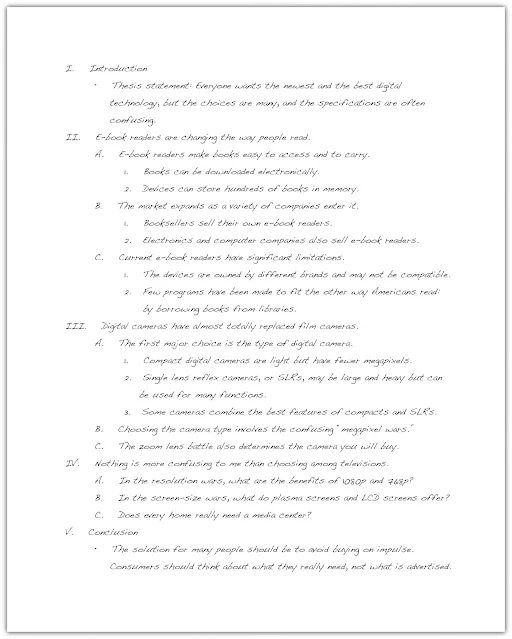
Each set of information consolidated beneath a Roman numeral serves as the foundation for a paragraph in your final paper. While the earlier example adheres to the conventional structure of a standard five-paragraph essay, it's essential to recognize that more extensive essays necessitate a proportional increase in both paragraphs and Roman numerals.
Should you anticipate a paragraph becoming overly lengthy or unwieldy, take the initiative to introduce an additional paragraph into your outline. This adjustment ensures a balanced and cohesive structure, with the main points renumbered accordingly. This strategic foresight in your outlining process not only maintains the fluidity of your writing but also contributes to the overall coherence and readability of your final paper.
Writing at work
PowerPoint presentations, a staple in both educational institutions and professional settings, share a striking resemblance to formal outlines in their organizational structure. These presentations typically feature talking points that the presenter expands upon, providing additional details and examples beyond what is succinctly presented on each PowerPoint slide.
8.3 Drafting
Drafting marks the pivotal stage in the writing process where you breathe life into a preliminary version of your written work.
Even seasoned writers concede that facing a blank page can be an intimidating experience, as the expectation to conjure something fresh and original with each new document looms large. However, having navigated through the initial steps of the writing process, you've successfully overcome the daunting "empty page syndrome." Hours dedicated to prewriting and meticulous planning now stand as your foundation. When you confront that blank page, it's not a void; it's a canvas waiting to be adorned with the substance meticulously outlined in your prewriting phase.
Getting Started: Strategies For Drafting
In this segment of Chapter 8, titled "The Writing Process: How Do I Begin?" your goal is to compose the body paragraphs for a standard five-paragraph essay. The structure of such an essay encompasses an introduction, three body paragraphs, and a conclusion. If you find it more comfortable to commence your writing journey on paper rather than the computer, feel free to do so, with the option of transcribing it later before the revision phase. Another approach is to utilize a voice recorder, kickstarting your thoughts by verbally articulating a paragraph or two. While Mariah in this lesson opts for a computer-centric approach, you have the flexibility to choose between pen and paper or computer to craft your initial draft.
Making the Writing Process Work for You
What renders the writing process immensely beneficial for writers is its penchant for fostering alternatives to conventional practices, serving as a catalyst for the cultivation of one's most compelling ideas. The following strategies, whether employed individually or in tandem, have the potential to enhance your writing prowess and propel you forward in the writing process:
Embark with Familiar Territory: Commence your writing journey with the portion of the text you are most acquainted with. Whether it's the third paragraph in your outline or the initial paragraphs, this approach allows you to harness the momentum of readily available ideas. While paragraph lengths may vary, aim for a balance; excessively short paragraphs might lack substance, appearing abrupt to readers, whereas overly lengthy ones risk becoming verbose and losing reader interest. A general guideline is to craft paragraphs longer than a single sentence but shorter than a full double-spaced page.
Incremental Progress: Write one paragraph at a time, then pause. As long as you meet your assignment deadline, dictate the number of paragraphs you complete in each writing session. Strive for a steady pace, avoiding procrastination. Adhering to deadlines is a hallmark of effective writing practices.
Recharge with Short Breaks: Particularly advantageous for multi-page reports or essays, taking brief breaks can rejuvenate your mind. However, ensure these breaks do not stretch too long, as an extended hiatus may impede your ability to resume writing. Set an alarm to regulate your break time, and when the timer expires, return to your writing space with renewed focus.
Realistic Goal Setting: Be judicious in setting writing goals. If you allocate ten-minute breaks, adhere to the timeframe. If you identify a need for additional facts, commit to obtaining them. Consistently meeting your self-imposed goals fosters successful writing assignments.
Audience and Purpose: Maintain a constant awareness of your audience and purpose throughout the writing process. Whether crafting a single paragraph or shaping the trajectory of the entire essay, these considerations remain integral to producing impactful and purposeful writing.
Amidst all these considerations, consistently holding your purpose and audience at the forefront emerges as the paramount key to achieving success in writing. When your objective is persuasion, for instance, you will meticulously structure your facts and details in a manner that is both logical and compelling.
Your purpose becomes the guiding force shaping your sentences, directing the flow of your composition. Simultaneously, your audience becomes the compass dictating your word choices. Are you addressing experts, a general readership, fellow college students, or individuals with minimal knowledge about your subject? Persistently question what information your readers, with their unique backgrounds and experiences, require to comprehend your ideas. Consider how you can articulate your thoughts most effectively, ensuring absolute clarity and the utmost effectiveness in your communication. This constant interplay between purpose and audience is the linchpin for crafting writing that is not only clear but also resonates profoundly with its intended recipients.
Consider jotting down your purpose and audience on an index card, which you can easily affix to your paper or keep beside your computer. This card can serve as a personalized guide, containing notes to yourself—perhaps highlighting what your audience may not be familiar with or what essential information they need. By addressing these points, you ensure a comprehensive and tailored approach to your writing.
Take a moment to articulate precisely what you aim to convey to your audience or what specific information you intend to impart or persuade them about. By distilling your objectives onto this index card, you not only keep a clear focus during the writing process but also create a tangible reference that aligns your thoughts with the needs and expectations of your intended readership.
Writing at Work
In the professional sphere, many documents you generate are tailored to a specific audience for a designated purpose. Acquiring comprehensive knowledge about your target audience and tailoring your message accordingly proves to be immensely advantageous, even if your audience consists of colleagues or superiors. This holds true for various contexts, from crafting menu language that entices a particular clientele, such as promoting "organic romaine" and "free-range chicken," to understanding the diverse preferences of customers in mail-order businesses.
Take menu language, for instance – descriptors like "organic romaine" and "free-range chicken" are strategically chosen to resonate with a specific customer base, catering to their preferences, which may differ from those craving a hearty steak. Similarly, successful mail-order companies delve into the demographics of their customer base, enabling them to customize product descriptions in catalogs that precisely align with the tastes of their buyers.
Consider a skateboarder catalog versus a clothing catalog for mature adults – the product descriptions in each are meticulously crafted to cater to the unique preferences of their respective audiences. This nuanced understanding and customization not only enhance the effectiveness of the message but also contribute significantly to the success of the communication strategy.
Exercise
Using the topic for the essay that you outlined in Section 8.2 “Outlining”, describe your purpose and your audience as specifically as you can. Use your own sheet of paper to record your responses. Then keep these responses near you during future stages of the writing process.
My purpose: ____________________________________________
____________________________________________
____________________________________________
My audience: ____________________________________________
____________________________________________
____________________________________________
Setting Goals for Your First Draft
A draft represents a comprehensive iteration of a written piece, yet it falls short of being the final rendition. As you likely recall, the subsequent stage in the writing process post-drafting is revising. This critical phase provides the opportunity to refine your initial draft before applying the finishing touches during the editing and proofreading stage. Essentially, the first draft serves as a functional version, a canvas upon which improvements can be iteratively made in the pursuit of refining and perfecting your work.
Writing at work
In specific work environments, team-based writing is a prevalent practice where writers collaborate on the planning, drafting, and revising of documents, such as extensive reports, technical manuals, and the outcomes of scientific investigations. Notably, these collaborative efforts transcend physical proximity, with teams often working seamlessly over the Internet.
In an ideal collaborative setting, each contributor possesses the authority to add, edit, and remove text. Effective communication skills, alongside proficient writing abilities, prove paramount in these collaborative scenarios as disagreements may surface concerning style, content, processes, emphasis, and other pertinent aspects.
The software employed for collaboration, often termed groupware or workgroup support systems, facilitates the joint efforts of teams working on shared projects. This collaborative tool, embedded in some word-processing programs as a reviewing feature, is particularly valuable for smaller workgroups exchanging documents. It not only serves as a reviewing mechanism but also enables the insertion of comments, fostering effective communication and seamless collaboration.
Investing some time now to familiarize yourself with how the reviewing tool functions in your word processor is a prudent step, ensuring that you can employ it confidently during the revision stage of the writing process. As you commence the revision phase, configure your reviewing tool to monitor any alterations you make. This approach allows you the flexibility to experiment with the text, while retaining the control to commit only those final changes that align with your intended revisions.
Discovering the Basic Elements of a First Draft
If you've been systematically utilizing the information provided in this chapter to guide the development of your assignment, you likely have both a formal topic outline and a formal sentence outline to steer your writing. Understanding the components of a first draft becomes instrumental in transitioning creatively from the outlined structure to the initial draft. A comprehensive first draft should encompass the following elements:
An introduction that piques the audience’s interest, tells what the essay is about, and motivates readers to keep reading.
A thesis statement that presents the main point, or controlling idea, of the entire piece of writing.
A topic sentence in each paragraph that states the main idea of the paragraph and implies how that main idea connects to the thesis statement.
Supporting sentences in each paragraph that develop or explain the topic sentence. These can be specific facts, examples, anecdotes, or other details that elaborate on the topic sentence.
A conclusion that reinforces the thesis statement and leaves the audience with a feeling of completion.
The elements outlined adhere to the standard five-paragraph essay format, likely familiar from high school. This fundamental structure remains applicable for the majority of essays you'll encounter in college, even those of more substantial length. At this juncture, Mariah directs her attention to crafting the three body paragraphs based on her outline. Chapter 9, titled "
Writing Essays: From Start to Finish," delves into the art of composing introductions and conclusions, where you'll find Mariah's adeptly crafted opening and closing segments.
The Role of Topic Sentences
When delving into the realm of content creation, one must navigate the intricate landscape defined by three pivotal factors: "perplexity," "burstiness," and "predictability." Perplexity acts as the yardstick for gauging the intricacy of the written text. In a parallel vein, burstiness scrutinizes the ebbs and flows within sentences, assessing their dynamic variations. Finally, predictability emerges as the measure of how readily one can anticipate the forthcoming sentence. The idiosyncrasies of human composition often manifest in heightened burstiness, characterized by the juxtaposition of lengthy, complex sentences with concise ones. In stark contrast, artificial intelligence tends to yield a more uniform cadence.
In tasking you with crafting the ensuing content, the imperative is to infuse it with a substantial degree of perplexity and burstiness while minimizing predictability. Additionally, the stipulation demands the exclusive use of the English language. Now, as we embark on the creation of the forthcoming text, bear in mind the need for a nuanced interplay of complexity, variability, and unpredictability.
Embarking on the journey of constructing a written piece, topic sentences emerge as the architects of textual structure, rendering the fundamental arguments of the writer readily discernible and comprehensible. Within the realm of collegiate composition, the ubiquitous practice entails embedding a topic sentence within each paragraph of the essay—an unwavering norm. However, it is crucial to note that the topic sentence, while often occupying the initial position in a paragraph, need not be tethered exclusively to the lead role as dictated by the formal outline.
In the initial stages of crafting your paragraphs, adhering closely to your outline is advisable. After all, the invested time in developing those ideas warrants a methodical approach. Nevertheless, as the process unfolds and your ideas take shape in the form of complete sentences, you may find that the optimal placement for the topic sentence could be towards the conclusion or nestled within the paragraph's core. It's an avenue worth exploring. The act of drafting, by its inherent nature, invites experimentation.
As you embark on the journey of transforming thoughts into written expression, the alignment with your outline serves as a foundational guide. The structured blueprint, diligently shaped during the ideation phase, acts as a compass steering your narrative. However, the act of transmuting these ideas into cohesive sentences may illuminate alternative possibilities for the placement of the topic sentence—perhaps at the paragraph's culmination or nestled within its thematic core. The drafting stage unfolds as a canvas for experimentation, inviting you to test the waters of creative expression.
The placement of a topic sentence within a paragraph is a versatile choice, finding its home at the commencement, midpoint, or conclusion. The audience and purpose of an assignment often wield influence, dictating the optimal position for the topic sentence. In persuasive writing, where the intent is to sway opinions, the topic sentence typically assumes the lead role, positioned at the paragraph's outset. This strategic placement ensures the writer's viewpoint is unequivocally stated right from the start, a pivotal approach in persuasive essays.
The decision on where to situate the topic sentence extends beyond audience and purpose—it also hinges on the essay's organization or order. When information is structured by order of importance, the topic sentence may find its place as the concluding statement within a paragraph. The supporting sentences converge, building up to the crescendo of the topic sentence. Similarly, in chronological order, the topic sentence might assume the final position, as the overarching idea logically culminates at the end of the sequence.
In essays organized by spatial order, the topic sentence could hold a central position, nestled between the introductory and concluding details. Such essays often commence with vivid descriptions, providing readers with a mental image before delving into the paragraph's development. When the topic sentence assumes the middle position, it serves as the linchpin, harmonizing the preceding and succeeding details seamlessly.
Engage in critical reading throughout your writing journey, all the while holding onto the concept of topic sentences. You might uncover instances where these sentences deviate from their customary position at the onset of a paragraph. Fiction writers, for instance, often employ implicit or explicit topic ideas to guide readers through their narratives. In the realm of nonfiction, such as in popular magazines, authors strategically deploy topic sentences as deemed fitting, aligning with the audience and purpose. It's not uncommon for a solitary topic sentence to wield control over the development of multiple paragraphs. For a deeper exploration of topic sentences, refer to Chapter 6, titled "
Writing Paragraphs: Separating Ideas and Shaping Content."
Developing topic sentences and thinking about their placement in a paragraph will prepare you to write the rest of the paragraph.
Paragraphs
At the core of an essay and various other forms of writing lies the paragraph—an integral structural unit. Each essay paragraph introduces another interconnected main idea, contributing to the reinforcement of the writer's thesis or controlling concept. These related main ideas undergo thorough support and development, enriched by a tapestry of facts, examples, and pertinent details that serve to elucidate them. The process involves a deliberate exploration and refinement of one main idea at a time, enabling writers to construct a compelling case for their overarching thesis.
Paragraph Length
How long should a paragraph be?
Addressing this pivotal question boils down to a simple yet crucial response: "long enough." The length of a paragraph should be tailored to the requirements of articulating your points and expounding on your main idea effectively. Whether aiming to captivate attention or present concise supporting ideas, a paragraph can be relatively brief, comprising two to three sentences. Conversely, in the realm of a complex essay delving into abstract facets of philosophy or archaeology, a paragraph might extend to three-quarters of a page or more. The key lies in maintaining a sharp focus on the topic, avoiding digression. In the realm of college-level writing, a lengthy paragraph is permissible, given it adheres to the theme and purpose. As a general guideline, aim for paragraphs longer than a single sentence but shorter than an entire page of double-spaced text.
In the realm of journalism, brevity reigns supreme, often manifesting in concise two- or three-sentence paragraphs. This style accommodates the way people consume news, both online and in print. Blogs and various online information sources similarly embrace this paragraphing approach. Readers frequently skim through the initial paragraphs of numerous articles before honing in on the select few they choose to delve into more comprehensively.
Occasionally, you might discover that a paragraph you've composed extends beyond the threshold of maintaining your audience's interest. In such instances, the prudent approach is to divide the paragraph into two or more shorter segments. Introduce a topic statement or employ a transitional word or phrase at the commencement of the new paragraph to facilitate a seamless flow. Transition words or phrases serve as signposts, illuminating the connection between the evolving ideas.
Nevertheless, it is imperative to align your approach with your instructor's preferences and expectations for your draft. Many instructors anticipate the development of a mature, college-level style as you progress through the assignments of the semester. Adapt your writing style to meet the specific criteria outlined by your instructor to ensure your work resonates with the desired level of sophistication.
Exercise
To build your sense of appropriate paragraph length, use the Internet to find examples of the following items. Copy them into a file, identify your sources, and present them to your instructor with your annotations, or notes.
A news article written in short paragraphs. Take notes on, or annotate, your selection with your observations about the effect of combining paragraphs that develop the same topic idea. Explain how effective those paragraphs would be.
A long paragraph from a scholarly work that you identify through an academic search engine. Annotate it with your observations about the author’s paragraphing style.
Starting Your First Draft
Now, let's peer over Mariah's shoulder as she embarks on the journey of crafting her essay delving into the complexities of digital technology and the perplexing array of choices confronting consumers. As you observe her process, ensure your outline is within reach, complete with its thesis statement and topic sentences, accompanied by the notes you made earlier in this lesson regarding your purpose and audience. This review will foster the ideal mindset for both you and Mariah as you commence this writing endeavor.
Below is Mariah's thesis statement.
Here are the notes Mariah penned to outline her purpose and identify her audience.
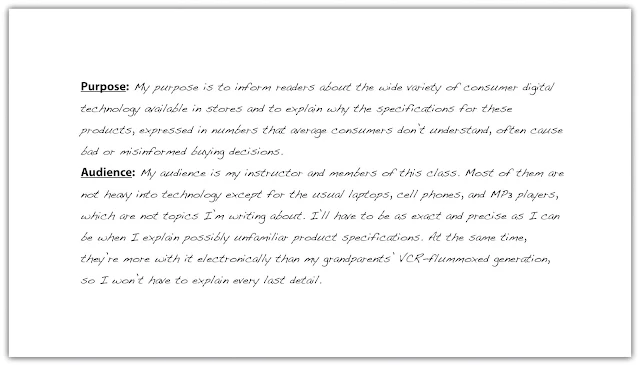
Mariah opted to initiate her essay with a swift introduction grounded in her thesis statement. She acknowledged the intention to enhance her introduction significantly during the revision phase. At this juncture, her goal was to establish a foundational starting point. You'll revisit her introduction in Section 8.4, titled "Revising and Editing," where she refines her initial draft.
Keep in mind the alternative approaches Mariah could have taken. Instead of commencing with the introduction, she had the option to initiate her essay directly from any of the body paragraphs.
Equipped with her thesis statement, purpose, and audience notes, Mariah turned her attention to the sentence outline. She opted for this outline due to its inclusion of the topic sentences. Below is the excerpt from her outline, specifically for the first body paragraph. The Roman numeral II designates the topic sentence, while capital letters denote supporting details, and Arabic numerals label subpoints.
Mariah proceeded to elaborate on the concepts outlined, translating them into a coherent paragraph. The structured outline played a pivotal role in ensuring that every sentence within the paragraph contributed to the development of the designated topic sentence.
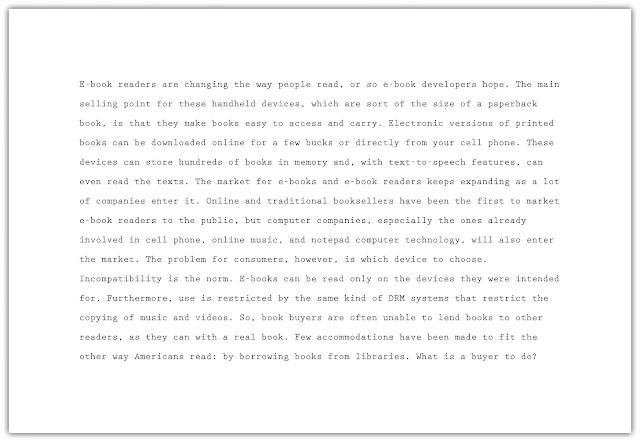
If you're composing your initial draft digitally, consider establishing a dedicated file folder for each course, supplemented by subfolders for individual assignments. Clearly label these folders with the corresponding course names and assign distinct titles to each subfolder and word processing document for easy identification—opting for the assignment name is a prudent choice for the document.
Within these subfolders, systematically store all the drafts you generate. When initiating a new draft, avoid overwriting the previous one. Instead, save each iteration with a new tag appended to the title—draft 1, draft 2, and so forth. This practice ensures a comprehensive history of drafts, facilitating submission if your instructor requests them.
Adhere to any formatting specifications outlined by your instructor in your documents, encompassing considerations such as margins, headers, page number placement, and other layout preferences.
Exercise
Study how Mariah made the transition from her sentence outline to her first draft. First, copy her outline onto your own sheet of paper. Leave a few spaces between each part of the outline. Then copy sentences from Mariah’s paragraph to align each sentence with its corresponding entry in her outline.
Continuing the First Draft
Mariah pressed on with her essay, advancing to the second and third body paragraphs. Although her outline featured supporting details, it lacked numbered subpoints, prompting her to refer to her prewriting notes for specific information to incorporate.
If you opt for a break between completing your first body paragraph and embarking on the next, resist the urge to start writing immediately upon your return. Take a moment to immerse yourself back into the context and mood by revisiting what you've already written. Mariah followed this approach. In the event she had interrupted her writing mid-paragraph, she could have swiftly jotted down brief notes to guide her on the forthcoming content.
Before each body paragraph that Mariah crafted lies the corresponding section of her sentence outline. Observe how she translated the expanded Roman numeral III from her outline into the initial draft of the second body paragraph. As you peruse, consider the fidelity with which she adhered to her purpose and how effectively she addressed the needs of her audience.
Mariah proceeded to initiate her third and concluding body paragraph, drawing inspiration from Roman numeral IV in her outline.
Exercise
Reread body paragraphs two and three of the essay that Mariah is writing. Then answer the questions on your own sheet of paper.
In body paragraph two, Mariah decided to develop her paragraph as a nonfiction narrative. Do you agree with her decision? Explain. How else could she have chosen to develop the paragraph? Why is that better?
Compare the writing styles of paragraphs two and three. What evidence do you have that Mariah was getting tired or running out of steam? What advice would you give her? Why?
Choose one of these two body paragraphs. Write a version of your own that you think better fits Mariah’s audience and purpose.
Writing a Title
A writer's optimal choice for a title is one that hints at the central theme of the entire essay. Similar to the headline in a newspaper or the prominent title in a magazine, an essay's title offers the audience an
initial glimpse into the content. If readers are captivated by the title, they are more likely to continue reading.
Following her outline meticulously, Mariah meticulously crafted each paragraph of her essay. Progressing methodically through the writing process, Mariah completed the draft, even incorporating a brief concluding paragraph (which you will encounter in Chapter 9, titled "
Writing Essays: From Start to Finish"). As a final flourish to her writing session, she decided to add a compelling title.
Writing Your Own First Draft
Now you may begin your own first draft, if you have not already done so. Follow the suggestions and the guidelines presented in this section.
8.4 Revising and Editing
In the quest to enhance your essay, two essential tasks demand attention: revising and editing. These constitute integral pillars of the writing process, playing a vital role in significantly elevating the quality of your work. It might be tempting to believe that a completed first draft requires minimal improvement. However, even seasoned writers recognize the ongoing need to refine their drafts and seek input from peers during the revising and editing stages.
Consider this analogy: athletes experience missed catches, fumbled balls, or goals overshot. Likewise, dancers grapple with forgotten steps, turns executed too slowly, or beats missed. For both athletes and dancers, the path to excellence hinges on consistent practice, progressively fortifying their performance. Drawing a parallel, web designers tirelessly pursue superior images, more ingenious designs, or backgrounds that exude greater appeal for their web pages. Writing shares this inherent capacity to thrive through dedicated improvement and revision.
Understanding the Purpose of Revising and Editing
Engaging in the processes of revising and editing empowers you to meticulously dissect two pivotal facets of your writing, allowing each task to receive your undivided attention.
During the revision phase, you embark on a second examination of your ideas. Here, the goal is to enhance clarity, accuracy, interest, or persuasiveness. This involves the thoughtful addition, removal, repositioning, or alteration of information to refine the overall expression of your concepts.
Moving on to the editing stage, your focus shifts to the manner in which your ideas are articulated. This involves a thorough review and potential adjustment of words used. Attention is given to rectifying any grammatical, punctuation, or structural issues. The objective is to elevate your writing style, transforming your essay into a polished and mature piece of writing—a testament to your utmost dedication and effort.
Wondering how to extract the utmost value from your revisions and editing? Here are strategies cultivated by writers to approach their initial drafts with a fresh perspective. Consider incorporating these practices throughout the semester, and persist with those yielding favorable results.
Take a Break: While you may take pride in your writing, sometimes proximity can hinder objective evaluation. Temporarily set aside your work for a few hours or even a day, allowing you to revisit it with a more impartial outlook.
Seek Trusted Feedback: Engage someone you trust for valuable feedback and constructive criticism. External perspectives can unveil aspects that you might have overlooked.
Step into Your Reader's Shoes: Imagine yourself as one of your readers. Assess whether you feel satisfied or dissatisfied and, crucially, understand the reasons behind these sentiments.
Utilize College Resources: Leverage the resources provided by your college, such as writing labs. Investigate the location and inquire about the assistance available both online and in person. These resources can offer valuable insights and support in refining your writing.
The terms "critic," "critical," and "criticism" often evoke negative sentiments, causing many to react with blushing, grumbling, or even shouting. However, as a writer and thinker, it's crucial to embrace a positive form of self-critique and maintain high expectations for your work. Developing the ability to be constructively critical of your own efforts is key, as is instilling confidence in your capacity to rectify any shortcomings. To achieve this, you must educate yourself on where to direct your focus for improvement.
Creating Unity and Coherence
Adhering closely to your outline provides a reasonable assurance that your writing will adhere to its intended purpose and not deviate from the central idea. However, under time constraints, fatigue, or when grappling with the struggle to find the right words, writers may find their work falling short of their aspirations. Clarity and conciseness may wane, and unnecessary information might find its way into the narrative.
Writing achieves unity when every idea, both within paragraphs and across the entire essay, is clearly connected and logically organized. Coherence, on the other hand, is evident when ideas seamlessly flow. The language used distinctly signals the progression from one idea to the next within a paragraph and from paragraph to paragraph.
An effective technique for identifying issues with unity and coherence in your writing is to read it aloud. This practice allows you to assess the clarity and flow of your ideas by listening attentively. Pay close attention to instances where confusion arises, and make a note to yourself about potential remedies for those areas. This auditory approach can unveil nuances that may not be as apparent when reading silently, offering valuable insights for refining your work.
Creating Unity
Occasionally, writers find themselves captivated by the moment, succumbing to the allure of an enticing digression. While such tangential explorations might be enjoyable in casual conversations, in the context of written pieces, unplanned digressions often undermine the coherence of the composition.
Mariah adhered closely to her outlined structure when formulating the three body paragraphs of her essay, tentatively titled "Digital Technology: The Newest and the Best at What Price?" Nevertheless, a recent HDTV shopping excursion stirred enough frustration in her that she deviated from the primary focus of her third paragraph. This diversion led her to include remarks about the sales staff at the electronics store she had visited. During the revision phase, Mariah excised the off-topic sentences, recognizing their adverse impact on the paragraph's unity.
To comprehend the difference brought about by Mariah's revisions, read the ensuing paragraph twice: initially without the implemented changes, and subsequently, with Mariah's judicious adjustments.
Nothing is more confusing to me than choosing among televisions. It confuses lots of people who want a new high-definition digital television (HDTV) with a large screen to watch sports and DVDs on. You could listen to the guys in the electronics store, but word has it they know little more than you do. They want to sell what they have in stock, not what best fits your needs. You face decisions you never had to make with the old, bulky picture-tube televisions. Screen resolution means the number of horizontal scan lines the screen can show. This resolution is often 1080p, or full HD, or 768p. The trouble is that if you have a smaller screen, 32 inches or 37 inches diagonal, you won’t be able to tell the difference with the naked eye. The 1080p televisions cost more, though, so those are what the salespeople want you to buy. They get bigger commissions. The other important decision you face as you walk around the sales floor is whether to get a plasma screen or an LCD screen. Now here the salespeople may finally give you decent info. Plasma flat-panel television screens can be much larger in diameter than their LCD rivals. Plasma screens show truer blacks and can be viewed at a wider angle than current LCD screens. But be careful and tell the salesperson you have budget constraints. Large flat-panel plasma screens are much more expensive than flat-screen LCD models. Don’t let someone make you by more television than you need!
In the process of reviewing your written work for potential improvements, adopt a systematic approach. During the initial pass, focus on assessing the overall unity of the content. Look for any elements that may disrupt the coherence of the narrative. Once you've addressed unity-related concerns, proceed to conduct a second sweep specifically dedicated to coherence issues. This methodical approach ensures that you can effectively pinpoint and rectify distinct types of problems in separate stages. Implementing this practice at various stages of the writing process can significantly enhance the quality of your work.
Writing at work
Numerous companies enlist the services of copy editors and proofreaders to ensure the production of impeccably polished final drafts for extensive writing projects. The role of copy editors involves proposing revisions and suggesting style enhancements, while proofreaders meticulously scrutinize documents for any lapses in capitalization, spelling, or punctuation. Frequently, these responsibilities are undertaken on a freelance basis, with individual freelancers serving a diverse range of clients.
Creating Coherence
Diligent writers employ transitions to elucidate the connections between ideas in their sentences and paragraphs. These words and phrases play a crucial role in ensuring a seamless flow in writing. While enhancing coherence can be achieved through various means, integrating transitions is often beneficial, imparting a sophisticated touch to your essays. For a comprehensive reference, consult, table titled "Common Transitional Words and Phrases," which categorizes numerous transitions based on their intended purpose.
Common Transitional Words and Phrases
Following Maria's efforts in refining unity, her subsequent focus shifted to scrutinizing the paragraph dedicated to televisions to ensure coherence. She meticulously examined the text, identifying areas that required the addition of transitions or potential rephrasing to enhance the lucidity of ideas. In the version presented below, Maria has already eliminated sentences that deviated from the main topic, aligning the content more closely with the intended flow.
Numerous writers opt to revise on a printed copy before transferring changes to the on-screen version. Conventionally, they employ a small arrow known as a caret (^) to indicate the precise location for inserting additions or corrections. This practice streamlines the revision process, allowing for a methodical and efficient approach to refining written content.
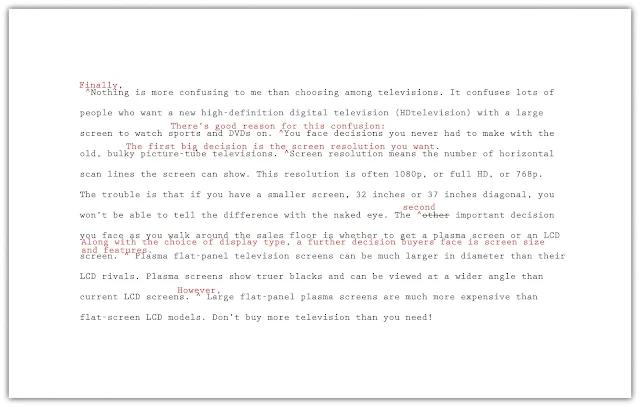
Being Clear and Concise
Some writers adopt a methodical and meticulous approach when crafting a first draft, while others release a torrent of words to express all that they feel compelled to convey. Whether your composing style aligns with either of these extremes or falls somewhere in between, the initial draft of almost any written piece, regardless of the author, can benefit from enhanced clarity and conciseness.
For those prone to verbosity, a careful review should target unnecessary words. On the other hand, if there's a tendency towards vagueness or imprecision in your expression, the task involves replacing overly general language with specific and precise terms.
Identifying Wordiness
At times, writers fall into the trap of using an excess of words when brevity would be more appealing to their audience and align better with their purpose. Recognizing and eliminating wordiness is essential as it enhances clarity, making ideas more direct and straightforward. Consider the following common examples of wordiness to watch for in your draft:
Sentences that begin with "There is" or "There are."
Wordy: There are two major experiments that the Biology Department sponsors.
Revised: The Biology Department sponsors two major experiments.
Sentences with unnecessary modifiers.
Wordy: Two extremely famous and well-known consumer advocates spoke eloquently in favor of the proposed important legislation.
Revised: Two well-known consumer advocates spoke in favor of the proposed legislation.
Sentences with deadwood phrases.
Wordy: As a world leader in the field of green technology, the company plans to focus its efforts in the area of geothermal energy.
A report as to whether or not to use geysers as an energy source is in the process of preparation.
Revised: As a world leader in green technology, the company plans to focus on geothermal energy.
A report about using geysers as an energy source is in preparation.
Sentences in the passive voice or with forms of the verb "to be."
Wordy: It might perhaps be said that using a GPS device is something that is a benefit to drivers who have a poor sense of direction.
Revised: Using a GPS device benefits drivers who have a poor sense of direction.
Sentences with constructions that can be shortened.
Wordy: The e-book reader, which is a recent invention, may become as commonplace as the cell phone.
My over-sixty uncle bought an e-book reader, and his wife bought an e-book reader, too.
Revised: The e-book reader, a recent invention, may become as commonplace as the cell phone.
My over-sixty uncle and his wife both bought e-book readers.
Choosing Specific, Appropriate Words
When composing college essays, it is essential to employ formal English suitable for an academic context. Adhering to the following principles ensures that your word choices are appropriate:
Avoid Slang:
Find alternatives to informal terms like "bummer," "kewl," and "rad."
Steer Clear of Overly Casual Language:
Opt for expressions like "men and women" instead of "girls and guys" to maintain a formal tone.
Avoid Contractions:
Replace contractions such as "don't" with "do not," "I'm" with "I am," "haven't" with "have not," and so forth. Contractions are considered too informal for academic writing.
Eschew Clichés:
Refrain from using overused expressions like "green with envy," "face the music," "better late than never," as they lack originality and may not resonate with your audience.
Exercise Caution with Homophones:
Be mindful of words that sound alike but have different meanings, such as allusion/illusion, complement/compliment, council/counsel, concurrent/consecutive, founder/flounder, historic/historical. When uncertain, consult a dictionary.
Select Words with Intended Connotations:
Choose words based on their connotations carefully. Whether positive like "proud" or negative like "arrogant" and "conceited," connotations play a pivotal role in formal essay writing.
Prefer Specific Over General Terms:
Substitute vague words like "thing," "people," "nice," "good," "bad," "interesting" with more specific synonyms. Alternatively, employ precise details to elucidate your intended meaning clearly.
For further insights into word choice, refer to Chapter 4, titled "
Working with Words: Which Word Is Right?". This discussion on refining your writing maintains an exclusive focus on the English language for optimal clarity and communication.
Dive into Mariah's latest revisions for her third paragraph, where she deftly enhances clarity and conciseness. Witness her adept incorporation of changes that elevate unity and coherence within the text.
Exercise
1. Answer the following questions about Mariah’s revised paragraph:
2. Now return once more to your essay in progress. Read carefully for problems with word choice. Be sure that your draft is written in formal language and that your word choice is specific and appropriate.
Completing a Peer Review
In the writing process, authors often find it essential to take a step back and seek input from an impartial reader. What writers truly benefit from is feedback from individuals who can respond solely to the words on the page. Once ready, writers share their drafts with someone they trust, seeking an honest assessment of its strengths and weaknesses.
You, too, can invite a peer to review your draft when it reaches completion. By evaluating the feedback and identifying the most constructive aspects, the reader's insights become invaluable during the revision phase. This collaborative approach is commonly referred to as peer review.
Within your class, you can collaborate with a partner to pinpoint specific ways to enhance each other's essays. Despite initial hesitations about sharing your writing, remember that every writer is striving for the same objective: a polished final draft tailored to the audience and purpose. Maintaining a positive attitude while providing feedback will create a conducive environment for both you and your partner. The subsequent box offers a helpful framework for the peer review session.
Questions for Peer Review
Title of essay: ____________________________________________
Date: ____________________________________________
Writer’s name: ____________________________________________
Peer reviewer’s name: _________________________________________
This essay is about____________________________________________.
Your main points in this essay are____________________________________________.
What I most liked about this essay is____________________________________________.
These three points struck me as your strongest:
These places in your essay are not clear to me:
a. Where: ____________________________________________
Needs improvement because__________________________________________
b. Where: ____________________________________________
Needs improvement because ____________________________________________
c. Where: ____________________________________________
Needs improvement because ____________________________________________
The one additional change you could make that would improve this essay significantly is ____________________________________________.
Writing at work
The inclusion of a reviewing feature in word-processing programs stems from the prevalence of workgroups in numerous businesses. Collaboration is a key aspect of writing, and within workgroups, members, along with their supervisors, frequently engage in critiquing each other's work. This constructive feedback loop is instrumental in shaping a superior final product.
Using Feedback Objectively
The essence of peer feedback lies in gaining constructive criticism for your essay. Your peer reviewer serves as your initial authentic audience, offering insights into what intrigues or perplexes a reader. This presents an invaluable opportunity to refine your work before presenting the final draft to a broader audience or your intended readership.
While it's not mandatory to incorporate every suggestion from your peer reviewer, recognizing patterns in their responses can be enlightening. If a consistent theme emerges, such as a call for more research, it might be worthwhile to consider integrating additional research into your future assignments based on that feedback.
Using Feedback from Multiple Sources
As you share various stages of your revised draft, feedback may come from multiple readers. In such instances, you might encounter responses from individuals who lack a full understanding of the assignment or who don't share your level of engagement and enthusiasm for it.
To effectively assess this feedback, consider two crucial criteria:
Alignment with the Assignment's Purpose:
Evaluate if the feedback aligns with the intended purpose of the assignment.
Appropriateness for the Audience:
Determine if the suggested revisions are suitable for the target audience.
With these criteria in mind, you can then decide whether to accept or reject the revision feedback, ensuring that it contributes meaningfully to the assignment's purpose and resonates with the intended audience.
Editing Your Draft
If, like Mariah, you've been incorporating each round of revisions, you've likely generated multiple drafts of your writing. Up to this point, your focus has been on content changes. Guided by peer feedback, you've ensured robust support for your ideas, addressed issues of unity and coherence, and fine-tuned word choice by eliminating unnecessary words and replacing weak language with precise and fitting expressions.
The subsequent phase following content revisions is editing. During this stage, you scrutinize the surface features of your text, paying attention to spelling, grammar, usage, and punctuation. Additionally, you ensure adherence to the proper format when finalizing your assignment.
Editing is a time-consuming yet essential aspect of the writing process. Allocating time for editing post-revisions enables you to perform additional edits, contributing to the creation of a polished work that reflects your best efforts. Consider these additional tips concerning your readers:
Correct Spelling Goes Unnoticed:
Readers typically don't pay attention to correctly spelled words, but they do catch misspellings.
Sentence Structure Matters:
Readers tend to skim through sentences to grasp your ideas, unless the sentences are awkward, poorly constructed, and challenging to read.
Variety in Sentence Rhythm is Key:
Readers notice monotony when every sentence follows the same rhythm. Introduce variety for a more engaging reading experience.
Correct Usage of There, Their, and They're:
While using there, their, and they're correctly might not earn cheers, readers certainly notice when they are misused.
Attention to Detail Matters:
Readers will appreciate the care and attention you put into handling your assignment, particularly in delivering an error-free document.
The initial section of this book provides a valuable overview of grammar, mechanics, and usage. Leverage this resource to effectively eliminate significant errors in your writing and enhance your grasp of language conventions. Additionally, don't hesitate to seek assistance from peer tutors within your academic department or the writing lab at your college. In the interim, utilize the checklist to guide you through the editing process for your writing.
Checklist
Editing Your Writing
Grammar
Are some sentences actually sentence fragments?
Are some sentences run-on sentences? How can I correct them?
Do some sentences need conjunctions between independent clauses?
Does every verb agree with its subject?
Is every verb in the correct tense?
Are tense forms, especially for irregular verbs, written correctly?
Have I used subject, object, and possessive personal pronouns correctly?
Have I used who and whom correctly?
Is the antecedent of every pronoun clear?
Do all personal pronouns agree with their antecedents?
Have I used the correct comparative and superlative forms of adjectives and adverbs?
Is it clear which word a participial phrase modifies, or is it a dangling modifier?
Sentence Structure
Are all my sentences simple sentences, or do I vary my sentence structure?
Have I chosen the best coordinating or subordinating conjunctions to join clauses?
Have I created long, overpacked sentences that should be shortened for clarity?
Do I see any mistakes in parallel structure?
Punctuation
Does every sentence end with the correct end punctuation?
Can I justify the use of every exclamation point?
Have I used apostrophes correctly to write all singular and plural possessive forms?
Have I used quotation marks correctly?
Mechanics and Usage
Can I find any spelling errors? How can I correct them?
Have I used capital letters where they are needed?
Have I written abbreviations, where allowed, correctly?
Can I find any errors in the use of commonly confused words, such as to/too/two?
Exercise caution when heavily relying on spelling and grammar checkers. A spelling checker may not discern your intent, such as writing "principle" instead of "principal." Similarly, a grammar checker might question constructions that are perfectly valid. These programs operate based on a general set of formulas, lacking an understanding of the nuanced meaning in each context. If you choose to use a grammar checker, acknowledge sensible suggestions, but also contemplate the reasons behind the suggestions provided.
Proofreading demands patience, as it's remarkably easy to overlook errors. Allow your paper to rest for at least a few hours, if not a day or more, to give your mind a break. Some professional proofreaders adopt the technique of reading a text backward to focus on spelling and punctuation. Another effective method involves reading your paper aloud slowly, meticulously attending to every word, letter, and punctuation mark.
For additional proofreading assistance, consider reaching out to a reliable friend, a classmate, or a peer tutor to conduct a final review, catching anything you might have missed.
Formatting
Don't forget to adhere to the proper format when finalizing your assignment. In certain instances, an instructor, department, or college might specify particular guidelines regarding titles, margins, page numbers, or the placement of the writer’s name. These requirements can be more intricate and stringent, especially for research projects and term papers, which often align with the American Psychological Association (APA) or Modern Language Association (MLA) style guides, particularly when citations of sources are involved.
To ensure accuracy and compliance with specific instructions, perform a final check before submitting your assignment.
Refining Your Writing
Throughout this semester, you've acquired numerous tools for generating ideas and transforming them into diverse essay types and research papers. You've honed your skills through the practice of crafting various essays, anticipating their relevance in future courses.
While you possess a repertoire of writing tools and hands-on experience, the journey of learning and improving in writing is ongoing. The writing process is perpetual, offering room for continual enhancement and the acquisition of new methodologies.
Beyond the ability to apply tools for idea generation and essay organization, the next phase involves refining your writing.
Chapter 7 of our online text introduces tools to initiate this refining process. Dive into
Chapter 7 to explore how these tools can elevate your writing to the next tier of improvement.
Reflection Essay Assignment
Considering everything we have covered this semester, in this last essay write about your growth as a writer. Provide 2 typed pages of reflection on your own endeavors throughout this course. This assignment is open to your interpretation. As long as you provide an insightful and thoughtful reflection on your time in English 101, you should receive full credit. This assignment cannot be turned in late and is due on or before the last day of class.
Consider the following while writing:
What was the hardest assignment for you to write, personally, and why?
What do you think was the most rewarding skill or tool you have learned about writing this semester and why?
Which essay assignment was your favorite? Least favorite?
What would you like to have spent more time learning/reviewing?
What have you learned about yourself not only as a writer but in general?
Things to Do:
Take time to consider the points you want to include in this paper so that you showcase what you have learned and how your writing has improved. Make sure you center your essay around a central point, or thesis, that you place at the end of your introductory paragraph. Support your points. Don’t merely list information or impressions. Settle down and explain yourself and connect your thoughts as you move from one fully developed paragraph to the next.
Essay Guidelines:
All essays must be typed, double spaced, in Times New Roman font, 12 point
This paper is to be a minimum of two pages.
You can select either APA or MLA formatting style when completing this essay assignment. Please refer to the Formatting Exercise in Unit One for how to set up your assignment in either style. Remember, with APA style, you must include a title page with your assignment. The title page will not count toward the two required pages of content that you are expected to submit for this essay assignment.
You are expected to use proper grammar and mechanics — refer to a grammar guide as needed.
Reflection Essay
Assignment
It’s a toss
up between the persuasive essay and the final research paper the reason is
because with the persuasive one I picked a topic that I know really well but
despite that it was a really technical process and I tried to break it down so
easy that even someone with no knowledge could complete the process to make a
working game server. As I was writing it I kept thinking about how much I
struggled when I first was learning how to make one myself because the guides
where very vague so I was worried I wouldn’t capture the completed effect but
despite that I feel like I did a good job at the end. The final research paper
I always find it difficult to get a topic that you can utilize quotes from
other documented information. I also picked a topic that I had actual
experience with and a potentially controversial topic. I was trying to
challenge myself in keeping a good flow throughout the topic while being able
to provide real experiences and then quoting from the religion that I was
forced into going to. I feel like I did what I set out to do with the research
paper.
As for
skills and tools I’ve had quite a few different writing related courses in my
life time including another college one when I was younger, I always find it
interesting to see different teachers teaching methods and the way information
is explained and understood I feel like this course really gave me good
challenges to make me think about how to write better.
When we
talk about favorite and least favorite, I really don’t have one honestly each
one gave me a challenge and I never thought that I disliked that challenge so
for me I really liked the whole course.
Considering
I enjoy writing even though the writing course is almost over I’ll keep
challenging myself and spend my own time learning and reviewing more. We have
free courses offered to us at work that have more detailed and challenging
writing courses that’s why before I even took this, I had already completed
some of those such as:
7/1/2019 09:47 PM
Clarity and Conciseness in Business Writing
7/1/2019 09:22 PM
Creating Well-constructed Sentences
7/1/2019 08:27 PM
Audience and Purpose in Business Writing
And there’s more that
I haven’t had the chance to complete that I will go over now that I have much
more down time at work.
I
learned that I’ve always really enjoyed writing and I can be good at certain
types of writing. I get a lot of good comments from people often that I write
good emails at work and they can always understand what I’m trying to say when
I make training documents. I also realized that I like the challenge of
assignments too.
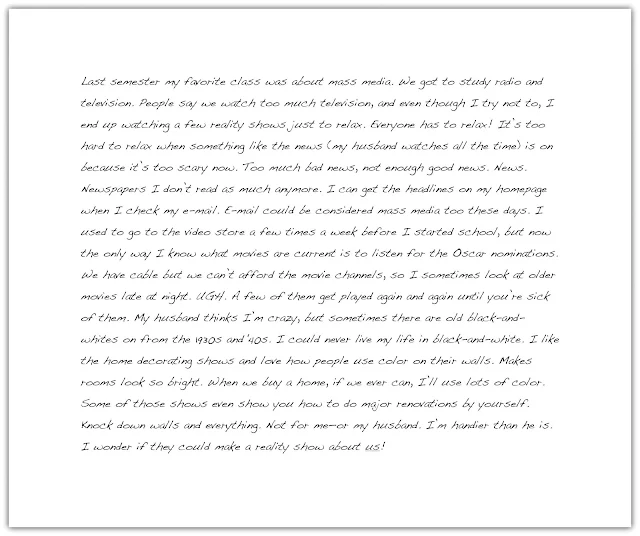





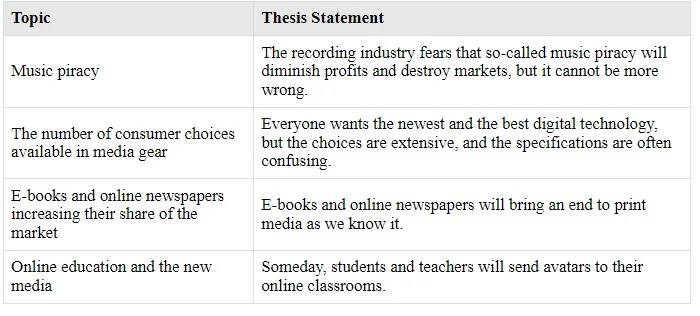
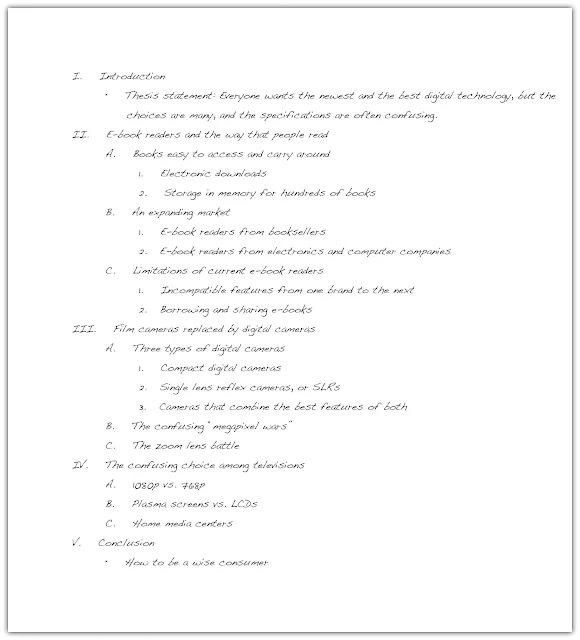



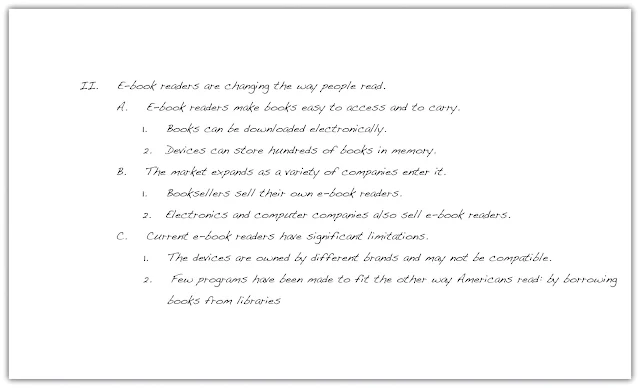

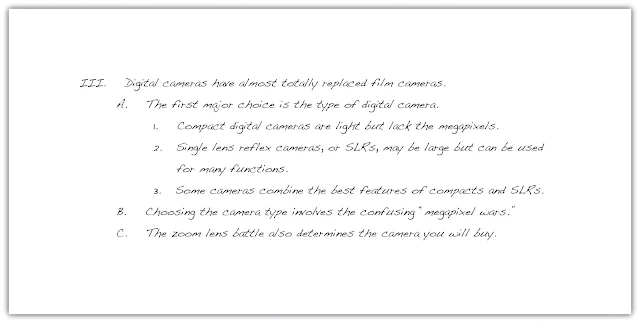

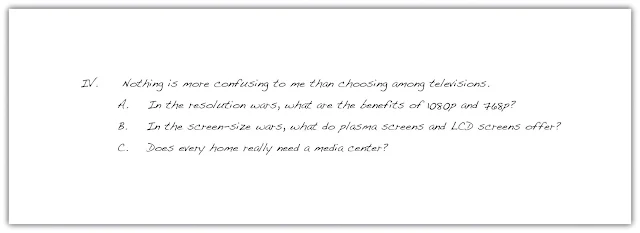
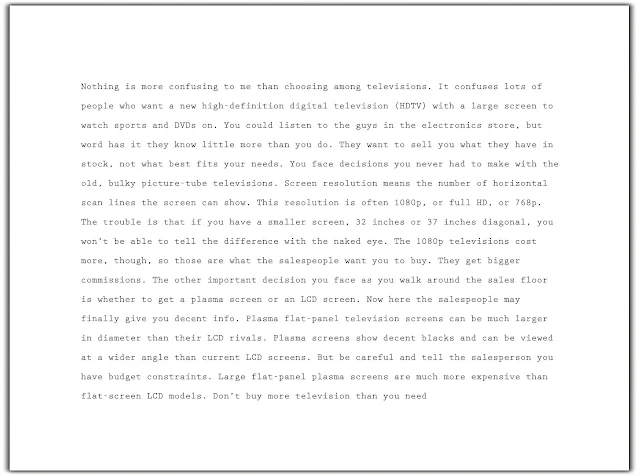
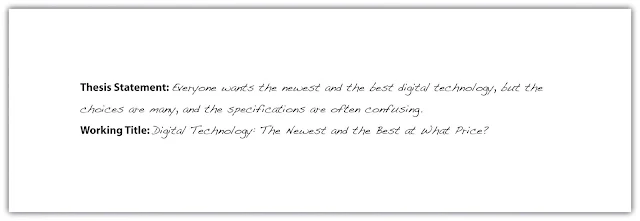
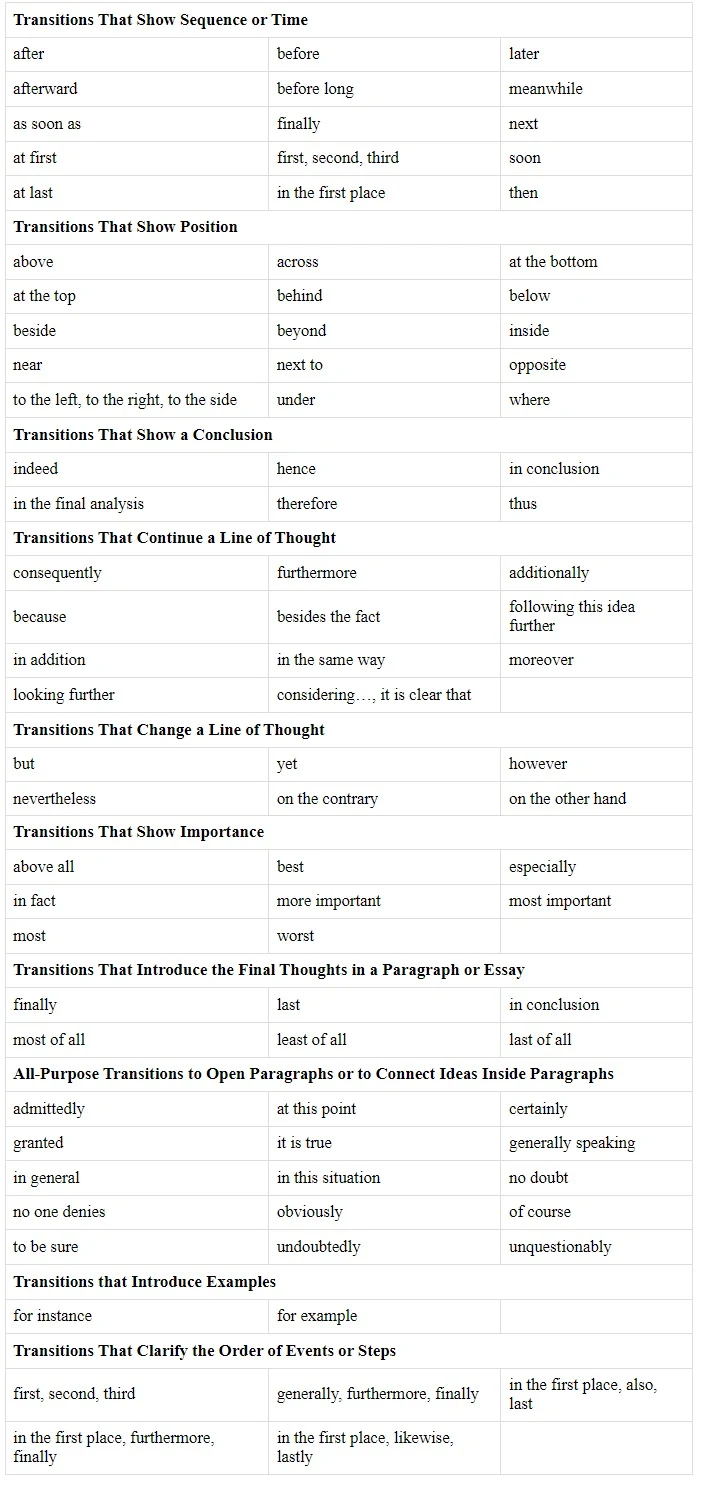

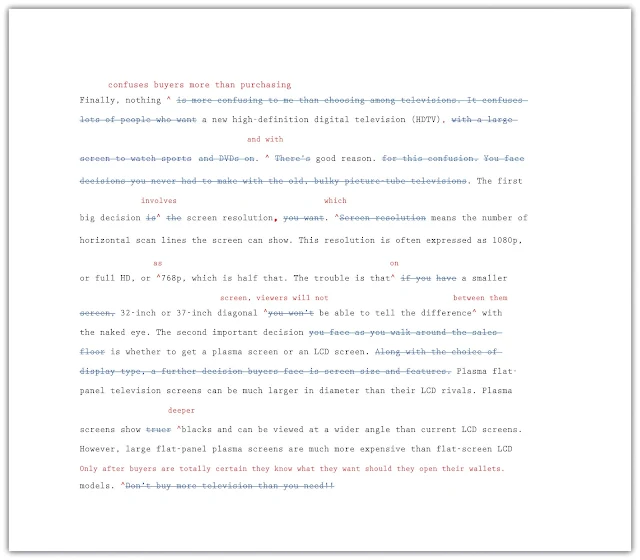
Comments
Post a Comment